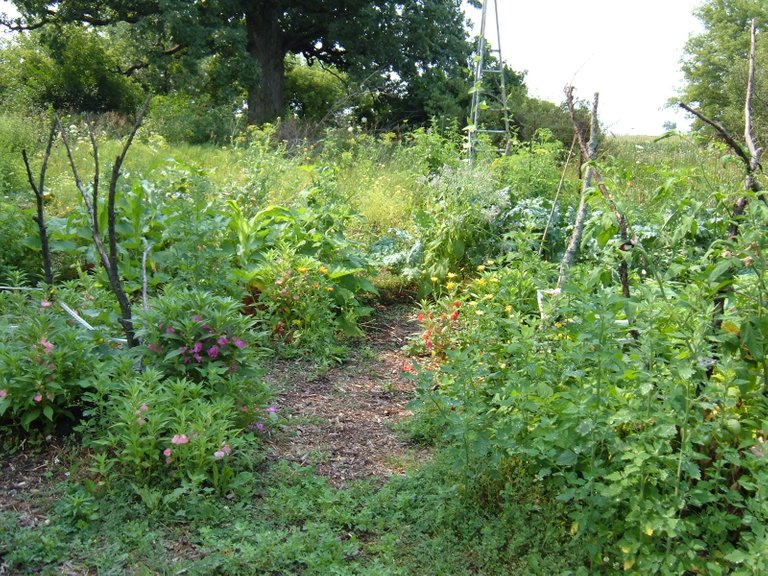Why build soil? Well for me, it's a love affair. Healthy living soil makes healthy plants, and healthy plants make healthy people. Not to mention soil is the foundation of life.
The fact that there are more microorganisms in a teaspoon of healthy soil (1 gram) than there are people in the world blows my mind. There is a divine symbiosis between carbon, nitrogen, minerals, bacteria, mycorrhizal fungi, protozoa, and scores of nematodes and worms. Microorganisms are attracted to the area around the roots called the rhizosphere. Plants have extensive nets of very fine root hairs that take up nutrients from microorganisms and fungi. Plants exchange carbohydrates and sugars in exchange for minerals and micronutrients. Essentially making cake for them. In return the mycorrhizal fungi dissolves rock minerals into soluble nutrients for the plants. Fare share, the beauty of symbiosis. Mycorrhizal fungi acts kind of like the earths inner internet, delivering nutrients and information.
Now let's build some healthy living soil.
Soil Building Blocks
Healthy Soil building starts with life's building block "Carbon". Lasagna Gardening aka Sheet Mulching is a great way to get carbon material into the soil.
STEP 1: Solarize Your Lawn
Put down 6 to 10 sheets of newspaper so that it completely covers the area you want to plant. Smothering your lawn with newspaper or cardboard (solarizing grass) saves you time and energy allowing the carbon in the soil to stay where it belongs in the earth. It turns out every time we till the earth we allow large amounts of co2 in the soil to evaporate into the atmosphere (accelerating global warning). Not to mention tilling also destroys the habitat needed to foster living microorganisms in the soil. No bueno!!!!! If you use newspaper, don't us the glossy ad pages. The inks may be harmful to the environment.
STEP 2: Layer Green and Brown Organic Matter like a Lasagna
Add in 2 to 3 inch layer of nitrogen rich material (green matter). Cow, poultry, pig manure, grass clippings, coffee grounds and finished compost all are great sources of green matter. Next layer add 4 to 5 inches of carbon rich items (brown matter). Leaves, straw, and shredded newspaper work well. Add yet another layer of nitrogen and finish it with a straw mulch layer. When you are done, your lasagna garden will be about 1 foot high from the ground. As the materials break down the mound will shrink and absorbed by the soil. If your in an desert region I suggest digging the bed a foot down and build the soil up from there.
STEP 3: Add Organic Amendments For a Nutrient Dense Garden
Most amendments are added to improve the structure of the soil. The lasagna garden will be rich in nitrogen with all the green matter added. What the garden will need is phosphorus and potassium for plants. Add wood ash for phosphorus (potash). Compost made primarily from food products is an excellent source of potassium. Particularly banana peels and red bell peppers are high in potassium. Adding biochar, rock dust, calcium, iron, and seaweed to your compost will allow minerals to be more soluble. The spring and fall time is are are the best times to add compost to your garden. Just way to much heat for the plants in the summer, use actively aerated compost tea instead.
STEP 4: PLUG AND PLAY
Get Transplants and seeds into your lasagna garden and water as needed. Continue building healthy soil and have fun!!!
OTHER WAYS TO SEQUESTER CARBON.
Hugelkultur
http://inhabitat.com/diy-hugelkultur-how-build-raised-permaculture-garden-beds/
Cover crops
http://www.rodalesorganiclife.com/garden/cover-crop-basics
Biochar
http://www.motherearthnews.com/organic-gardening/making-biochar-improve-soil-zmaz09fmzraw.aspx
Forest_gardening
https://en.wikipedia.org/wiki/Forest_gardening
Compost Tea




Excellent article! Your directions are very clear and accurate. This is the best way to build good soil from scratch. It is usually a lot cheaper to find some of these materials than it is to buy bags of soil.
When lasagna gardening (aka sheet mulching), it is good to keep a couple of things in mind: (1) You are right that one needs to use more of the carbon-rich "brown" materials (straw, dead leaves, cardboard, newsprint, etc.) than nitrogen-rich "green" materials (food scraps, manure, coffee grounds, lawn clippings from non-treated yard, etc.). Sooner or later, it will all break down, but for the fastest results, it's useful to know about the C:N ratios of different materials. Check out this site and scroll down for a list of common ingredients and their C:N ratios. Somewhere around 20:1 or 30:1 is a pretty good goal for the whole thing. http://www.homecompostingmadeeasy.com/carbonnitrogenratio.html
(2) Water it well. Keep it wet. The whole mess stays above the ground and it drys out really fast in many climates. If it gets too dry, the process grinds to a halt. Keep it moist, but not too soaking wet as to cool it down. This is tough if you use cardboard sheets, but easier to distribute water to the layers if you use other Carbon sources like leaves or straw.
Yes, you are right: plant in it right away. The plants know what to do. The first year will be good. The second year will be OMG!!! Good soil is black gold.
Thanks @donkeypong, I appreciate your vote and comment. I'm really happy with today's harvest from the lasagna garden.

Be well
I've been doing it all wrong.. Thanks!
Articles like this are music to my ears (ok I guess eyes), but you know what I mean. Such a pleasure to read a thoughtful informative article after so much blah blah. Keep writing! Look forward to seeing what you get up to, definitely following! Cheers @ecokonwme
Great article. I'd suggest a companion article about how to maintain your soil afterwards. People overuse chemicals to get perfect lawns and crops and that can really strip the soil of the microorganisms used to keep it healthy. When I had a lawn, I kept it chemical free and saw deeper roots and stronger grass because of it.
Happy you enjoyed the article @bittrex-bill. Thanks for not using chemicals too. Be well.
An amazing post, thanks so much for sharing your "love affair" with soil.
It really is mind blowing what is going on in soil - there is a whole world communicating in there!
At a permaculture farm in New Zealand that I recently WWOOFed at we used "manure tea" during the summer - it was a mix of horse manure and comfrey that soaked in water for three weeks. Every time I distributed the manure tea on the soil I noticed an immediate growth of all of the plants!
Thank you @anwenbaumeister. I love seeing how plants respond to compost tea or manure tea. Thanks for sharing your wwoofing experience. I would love to visit New Zealand someday. Happy gardening.
Great post dude! keep it coming! I have done this almost exact method using cardboard instead of newspaper. @ Satoshi Garden
It works great! Worth Spreading!
Thanks @Forrestwillie!!! Happy to hear there are people out there building soil.
This reminds me of the way I built my Hügelkultur mound for my garden. Very nice.
Nice, I mentioned Hügelkultur at the bottom of the post. Thanks @jonnyrevolution!!!!
thanks @robertleal!
Another way I put nitrogen in my garden is in the fall. I mow the fallen dried leaves on my lawn and either rake them up with the grass clippings or catch them in the mower bag and then put the mixture directly on my planting beds. It's a great winter mulch and the soil in the spring is thusly amended.
nice post.. ^^
yes i think so
Great information. I bought a house with a badly neglected garden and had to build up the soil using a lausanga method. The results were fantastic.
Here's a link to my post showing what it took to get the garden back on track.
https://steemit.com/garden/@oneboringdude/getting-the-garden-ready-for-winter-oneboringdude
Yes, this is indeed the way to go. The more organic matter, the better. Feed that soil life and don't kill it with chemicals.
This is a fantastic article, everything starts with healthy soil, nutrient dense soil. very good information.